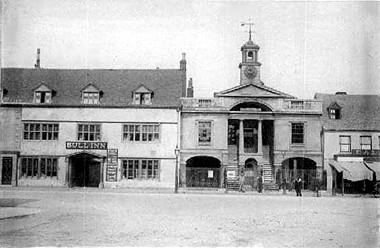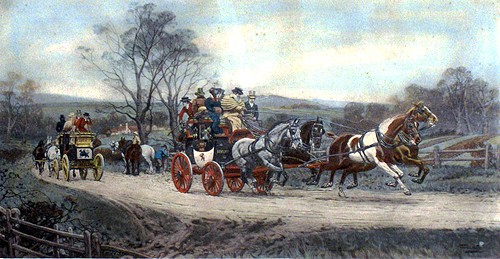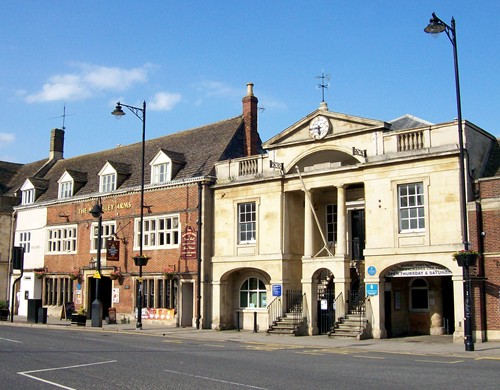|
Joseph Brightmore THE PERILOUS LIFE OF A 19th
CENTURY
The story of coachman Joseph Brightmore two centuries ago is one of resilience and fortitude in the face of extreme adversity and therefore deserves a worthy place in our history. The stagecoach had a long association with Bourne because the town was on the main route between London and the north and during the 18th and 19th centuries, passengers travelling to and from Lincoln, York and even Scotland, passed through. Both the Angel Hotel and the Bull Inn opposite were well known posting houses where the horses were stabled and travellers given food, drink and sometimes overnight accommodation. Among them was the Lincoln Flyer which operated between Lincoln and London from 1785 and 1871, a distinctive coach with dark-blue painted bodywork and a canary yellow top section, the drivers wearing long, yellow waistcoats to distinguish them, while the trip between the two centres took ten hours with horses being changed every nine to 19 miles, according to the location of the posting inns on the route. The life of the coachman was a hard one because they travelled on the top the coach in all weathers, risking wind, rain, snow and storm, and the safety of their passengers was of paramount concern while the possibility of accidents or being held up by highwaymen was always with them. Joseph Brightmore was one of the leading drivers of the Lincoln Flyer and he arrived in Bourne on Wednesday 10th October 1821 on his regular run driving the stagecoach from London to Lincoln and stopping at the Bull Inn [now the Burghley Arms] to change horses and allow passengers time for rest and refreshment. After a short break and with a new team, he was about to resume his journey when the animals took fright and bolted, pulling the coach over a heap of stones and building materials that had been left lying in the road outside the new Town Hall where it overturned. Brightmore was thrown off and badly injured, breaking both arms and one of his thighs, and was carried into the inn where medical assistance was summoned. Miraculously, no one else was hurt but the driver was in a parlous condition. “The unfortunate man lies in a very dangerous state”, reported the Stamford Mercury the following Friday. “He had deservedly the character of a steady coachman and was highly respected at Lincoln where he has a wife and large family.” His condition remained extremely serious for many weeks and the newspaper reported on Friday 28th December: “We are sorry to learn that the poor man still lies confined to his bed at Bourne, though every possible attention to his wants have been administered, and that it was only a few days ago that he was capable of being removed in order to change the linen and adjust the bed. As his case is a compound fracture, little hopes are entertained of his speedy recovery.” But Brightmore, who was 43, did recover although it took many months, and despite being disabled for life by his injuries, three years later he was back on the road, this time as owner driver of his own stagecoach, no doubt using the money he had received in compensation to finance his new business. “His coach, of no small importance, has commended running through the numerous villages from Lincoln to Grantham”, reported the Stamford Mercury on Friday 3rd December 1824. “The line of country through which it passes will hail this real accommodation and give the proprietor every support for its continuance. Joseph Brightmore, the late driver of the Express coach, who was so unfortunate as to receive severe injuries by the overturning of that coach at Bourne from the incautious placing of some stones upon the road. He anticipates that supporting of a wife and family by his own exertions in the undertaking and, cripple as he ever will be from the accident referred to, it is hoped his urbanity, attention and carefulness will ensure him success in his laudable efforts. By his coach, a connection is opened with Melton Mowbray, Leicester etc, from Grantham.” Brightmore remained in coaching for several years before retiring to become landlord of the Lord Nelson Inn near the High Bridge in Lincoln, where he frequently regaled customers with tales of his time on the road. The accident at Bourne, however, had been only one of many to befall him because in 1844, when he was 66, he was admitted to the county hospital with a fractured leg having in the course of his life suffered from broken bones or dislocations on thirty occasions and had recovered each time. Then when he was 74 and now living in retirement , he was caught up in the floods that inundated Lincoln in the winter of 1852 after the River Witham burst its banks, trapping families in the nest of small houses where he lived, and the Stamford Mercury reported on 3rd December: “Persons well acquainted with this locality say that the people are in a wretched state of want and that in the worst winters there necessities have never been so extreme as they are now, the men being out of employ and the families being pent up in their home starving. Poor Joseph Brightmore, the old coachman, who has gone through so many perils, was in his chamber for a week until starvation rendered him desperate, when he forced his way from his prison almost up to the neck in water.” Despite these continual privations, he lived for another six years and died at Lincoln on Friday 28th August 1858 at the age of 80, his body bearing the scars of the many accidents that had befallen him during an eventful career although never once did he falter in his resolve to make the most out of life and continue to earn his own living. He and his wife, Ann, had five children and the Brightmore name now shines brightly in the world of genealogy on both sides of the Atlantic where descendants are exploring their ancestry and so perhaps this brief account of his career will add some colour to their researches.
REVISED JUNE 2013
Go to: Main Index Villages Index |


